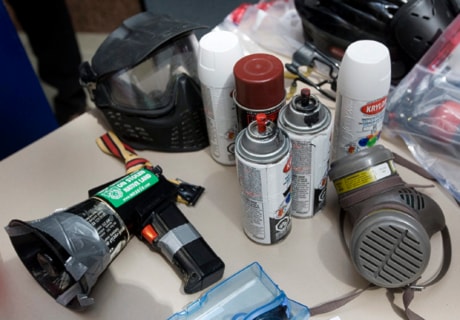TORONTO — Police defended their G20 tactics with a display of seized weapons — some of which were not summit related — and Toronto residents found out the five-metre fence rule never existed as the city continued to digest the fallout of hosting the world leaders.
Arrows with flammable tips, bear spray, and tire irons were among the weapons seized from G20 protesters intent on wreaking havoc in Toronto, police Chief Bill Blair said.
“They came to attack the summit,” Blair told a news conference as he defended his force amid a storm of controversy.
“When they couldn’t attack the summit they attacked the city, and they became a mob. A mob is policed a little differently than a lawful, peaceful protest.”
At least two items on display — a chainsaw and a crossbow — were not G20 related, Blair conceded. They were seized from a man last Friday a few blocks away from the security zone. And there were reports the chain-mail vest also paraded out belonged to a man heading to a role-playing fantasy game when he was stopped Saturday morning.
People who feared that venturing within five metres of the summit security zone without identification could land them in jail found out Tuesday that just wasn’t the case.
The government said the temporary regulation, passed in secret, granted police such powers only in the case of people entering the zone — not just passing by.
Neither police nor the government set the record straight last Friday when the five-metre rule was reported in the media. The confusion, it seems, came from the wording of the regulation.
Asked if there actually was a five-metre rule given the ministry’s clarification, Toronto Police Chief Bill Blair smiled and said, “No, but I was trying to keep the criminals out.”
Officers cracked down hard on summit dissent after a group of militant protesters using so-called Black Bloc tactics ran unimpeded down Queen Street West on Saturday afternoon. Their trail of vandalism culminated in police cars being set aflame at several locations.
Among those detained were members of the media, including several who found themselves trapped for hours between police lines in torrential rain on Sunday at a downtown intersection.
That tactic, known as kettling, was deployed by authorities during last year’s G20 summit in London. Police seek to encircle protesters and refuse to let those caught inside the ring to leave.
Toronto police have said they employed it because they feared violence was imminent as protesters marched down trendy Queen Street West.
Nathalie Des Rosiers, general council for the Canadian Civil Liberties Association, issued a report Tuesday unequivocally condemning some of the police tactics.
“Police conduct during the G20 summit was, at times, disproportionate, arbitrary and excessive,” said Des Rosiers.
“Despite instances of commendable and professional conduct, the policing and security efforts ... failed to demonstrate commitment to Canada’s constitutional values.”
In an interview with the Canadian Press, Des Rosiers said it was inappropriate for police to mislead citizens about the existence of the five-metre rule.
“They ought not to have mislead or led people under the impression that this was the law so they could secure consent to illegal searches. It’s inappropriate, it’s a breach of trust.”
More than 700 people were rounded up over the weekend. Some were rousted from their beds. Others were simply dragged from crowds.
The Integrated Security Unit said 900 G20-related arrests were made since June 18.
Police and politicians have rushed to defend what appeared to be arbitrary searches, seizures, arrests and detentions amid a chorus of condemnation from rights activists.
Blair took aim at what he called “Monday morning quarterbacking.”
“There were no further acts of violence (after Saturday), and the weaponry that you see displayed before you today is just a small portion of the evidence that we gathered of what is most certainly a criminal conspiracy.”
A police task force has been set up to review law enforcement actions during the summit. Forces from across Canada that formed part of the Integrated Security Unit are subject to the review, however each service is responsible for its own disciplinary action if misconduct is proven.
Anarchists employing Black Bloc tactics infiltrate large peaceful demonstrations wearing normal street clothing. They then change into black clothing and cover their faces in balaclavas or ski masks before fanning out and destroying symbols of capitalism.
Those arrested were taken to a film studio turned temporary jail, which had 650 people locked up at the height of arrests on Saturday night, despite being designed to hold 500.
On Tuesday, with the facility empty, police threw the doors open to media for a tour.
Over the weekend groups of about 20 people were placed into cells measuring three by six metres, which contained a portable toilet with no door, and a small bench, said Toronto Police Staff Supt. Jeff McGuire.
Orange prison jumpsuits, half-eaten sandwiches, empty water bottles, orange peels, Styrofoam cups, and sealed women’s sanitary pads litter the floors.
The facility was covered ceiling-to-ceiling with surveillance cameras and upon entering, prisoners could see a large poster board explaining their rights.
